The Car and the City
 Free parking for employees at places such as the U.S. Senate=blight, promotes driving, and supports the maintenance of unsound foreign and economic policies on the part of the U.S. government.
Free parking for employees at places such as the U.S. Senate=blight, promotes driving, and supports the maintenance of unsound foreign and economic policies on the part of the U.S. government.Is an excellent report published a number of years ago by the Northwest Environment Watch. No longer in print, it's available online here. It's well-written and makes many many good points. (Thanks for the heads up on this report go to Payton Chung.)
From the executive summary:
24 Steps to Safe Streets and Healthy Communities
from Alan Durning, The Car and the City
1. Read The Car and the City on the bus. What you see depends on where you sit. Good urban design creates public spaces that are safe and inviting; bad design results in a menacing public realm. But the difference is hard to see from the driver's seat.
2. Make streets in a grid. Put in diverters. A grid allows better traffic flow than the sprawl model of cul-de-sacs, feeder roads, connector roads, and highways. Diverters slow cars but allow bikes and pedestrians free movement.
3. Lay out small blocks with small lots. Compact scale creates a diverse but comfortable environment for foot travelers.
4. Surround the sidewalk with greenery. Good landscaping makes walking a pleasure.
5. Mix offices, shops, and homes. Blending these usually compartmentalized land-use categories allows proximity to replace mobility.
6. Install bike racks. Lack of bike racks is a major obstacle to bike use.
7. Build new high rise neighborhoods in depressed industrial zones. Well designed high-density neighborhoods are the essence of walkable cities. Underused industrial land is available around many city centers.
8. Fight urban crime. One-third of low-density dwellers in greater Seattle would be willing to live in a medium- or high-density neighborhood if they felt safe there.
9. Factor auto-dependence into mortgage qualification rules. If proximity allows households to shed their second or third car, they can save an average of $300 a month, enabling them to make larger loan payments.
10. Surround downtown with pedestrian voters. If business districts are surrounded by high-density, pedestrian-oriented communities, a pedestrian voting bloc will emerge to counter the motor lobby.
11. Don't exempt gasoline from retail sales tax. Gas taxes are user fees that pay only for roads. Sales taxes support the general functions of government, yet many states and provinces exempt gas on the spurious basis that it is already taxed.
12. Eliminate the mortgage interest deduction. The interest deduction is an incentive to buy bigger, more expensive houses -- often suburban mansions. It is one of the largest handouts in the U.S. tax code and a huge indirect subsidy to sprawl.
13. Calm traffic. Speed bumps, traffic diverters, and street-narrowing curb bubbles all slow traffic; fast traffic deters pedestrians and cyclists.
14. Complete the pedestrian infrastructure. One-third of Seattle streets lack sidewalks. Sidewalks should be wide enough to allow three people to walk abreast comfortably.
15. Build front porches. Front porches encourage walking and add to the sense of community in a neighborhood. [or stoops]
16. Fill in suburban neighborhoods. Raising density is the key to better transit and more local shops. Residential neighborhoods can begin by allowing "mother-in-law" apartments.
17. Hold a community meeting to develop a shared vision of the future. Change is fiercely resisted when it seems imposed by others.
18. Sell insurance by the slice. Pay-at-the-pump insurance lets drivers buy only the insurance they need. It also eliminates uninsured motorists.
19. Deregulate parking. Americans end 99 percent of auto trips at "free" parking spaces. But they're not actually free - someone pays for them. Deregulating parking would induce market pricing for most parking, allowing drivers to only pay for what they used.
20. Use parking meter proceeds for neighborhood funds. Charging for curbside parking ensures that drivers pay rent for their use of public rights-of-way. Using the proceeds for neighborhood improvements keeps the revenue in the community.
21. Ask your employer to take back your parking space and give you a $2,000 raise. Free employee parking is a tax-free fringe benefit worth $2,000 a year or more. Non- drivers get no similar benefit.
22. Exempt buildings from the property tax. Shifting property taxes off of buildings and onto land promotes re-development of urban neighborhoods.
23. Shift taxes off work and onto pollution. Partially replacing income taxes with fuel and vehicle use taxes helps both the economy and the environment.
24. Give The Car and the City to the person beside you on the bus.
Index Keywords: car-culture



0 Comments:
Post a Comment
<< Home